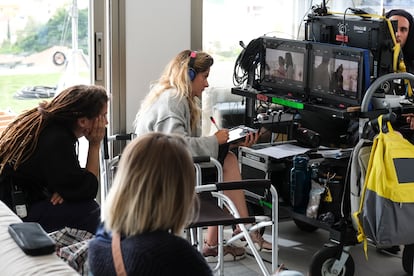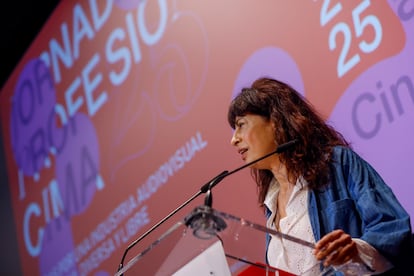The first great report of the Association of Women filmmakers and audiovisual media (CIMA) on sexual violence in the Spanish audiovisual industry draws a demolishing portrait of the sector. The main fact is conclusive: 60.3% of women declare having suffered some kind of sexual violence in spaces related to the film and audiovisual industry. Within that group, 49.5% say they have faced physical harassment. The investigation, which has been presented this Thursday and entitled After silence. Impact of sexual abuse and violence against women in the film and audiovisual industry, It is based on 312 surveys online answered by members of this organization (which has 1,300 members) and completed with work groups and interviews with experts. The main conclusion is that it is “an environmental environment for women.”
The analysis – realized by Nerea Barjola Ramos, political scientist and doctor in feminisms and gender, and Tardón Recio Bárbara, a doctor in interdisciplinary gender studies – explains why women do not reveal this type of aggressions: “92% of women who have faced sexual violence have not denounced it.” Only 6.9% have done so before a State Security Corps, Autonomous Police, Court or another Institution and 13.6% “They could tell a person in charge (Chief/EO Human Resources)”, although 94% did confess to a nearby person.
The causes that push not to report are varied. If 30% did not know how to proceed with the suffered, 27% did not do it for fear of reprisals and 22.2% because they believe that the complaint would not serve anything. Of those who did report, 46.2% have a “very bad” opinion of the care received. In addition, 64.4% of women “believe that complaints are not taken seriously”, a percentage that reaches up to 80% in the age strip of 20 to 29 years.
In the presentation of the report, the documentary filmmaker Almudena Carracedo —vocal of the Board of Directors of the top and a member of the Violence Commission – has explained that the report has been a year of work and stressed “the systemic of the aggressions”.
Naturalization and normalization of aggressions
Nerea Barjola has stressed that “there is a naturalization and normalization of violence in the audiovisual, they are integrated and are perceived as inevitable: everything leads to the culture of impunity. That happens by a structure that protects and generates violence, from interpretation schools to production offices. Even in scripts there are narratives that do not leave room for feminism.” And he has deepened that “young women suffer double violence: that of their age, therefore precarious economic condition, and that of the hierarchy.”
On the consequences, according to Barjola: “Violence goes beyond the direct fact, because it causes numerous consequences in the medium and long term. There is a collective silence, and this is the one that we have to take charge as a society. The context even revictimizes those who have suffered the aggressions.”
For its part, Barbara Tardón has influenced what remains to be done: “The findings are shocking, although not surprising. For example, that 92% who do not report is just the same percentage that appears in other surveys on Spanish and European society. We urge all competent public institutions and the audiovisual sector A, simply, comply implement their measures. ”

In the conclusions, after rebeling the studies and the methodology, the “existence of an impunity system that protects the aggressors within the film and audiovisual sector is noticed: impunity towards those who exercise violence is sustained by institutional silence and companies/producers/distribution platforms responsible for audiovisual projects. (…) The absence of effective mechanisms of denunciation or sanction Active or passive complicity of colleagues, colleagues, managers or entities of the sector, shield this impunity. the victim or survivor and directly and indirectly protects the aggressor. ”
Thus, the system consolidates “an environment work insecure for women.” According to the report, “a vacuum of effective instruments in the film and audiovisual industry is verified, such as the mandatory prevention and action protocols adapted to the recent legislative frameworks against sexual violence. In cases where there is some mechanism for a response to sexual violence, an alarming ignorance has been found by women of the industry of their existence (64% do not know prevention), also about its operation or about the information related to its application. hotlines (telephone lines in which to refer anonymously what is suffered) does not always guarantee its effective application (…). Professionals raise protocols as Wet paper Without an effective application where its implementation is a merely symbolic measure in a structure that does not guarantee compliance with measures ”.
The top report points out: “The film industry is not a neutral space; its structures reinforce inequality and legitimize sexual violence as part of the work. (…) Testimonies reflect that knowledge about the aggressors is collective and that, even so, it does not act against them. Phrases like ‘Everyone knows’ it evidence a structural complicity that allows the permanence of the perpetrators in the sector.”

Tardón points to the numerous responsibilities of the institutions, which he urges to comply with their own laws. There are recommendations for the Ministries of Culture, Equality and Work, for the Film Academies, for the Autonomous Communities and for Companies.
Among the authorities present – Cristina Hernández, director of the Women’s Institute; Virginia Yagüe, president of Lady, the Entity for the Management of the Rights of the screenwriters, who has collaborated in this report; The Eurodiputada Irene Montero (who as Minister of Equality promoted the law of only yes is, and Guadalupe Balaguer, president of the top – has spoken the Minister of Equality, Ana Redondo, who has underlined “the amount of values of this report, where the data does not kill the story. Progressive, “he explained:” It is time to change. Joined by an equal, diverse and violence audiovisual industry.

